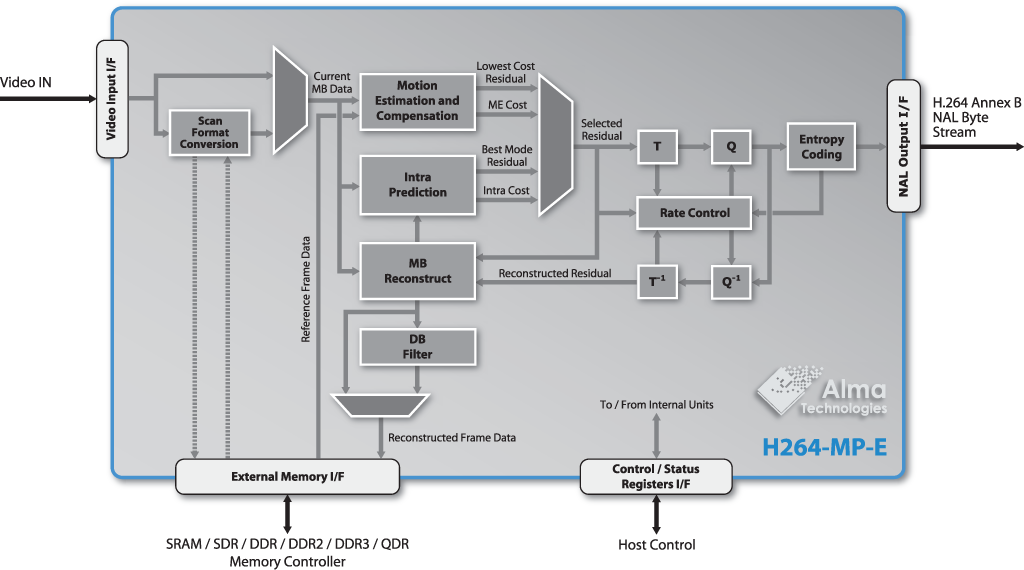H264-MP-E
Main Profile H.264 Encoder
|
|
|
|
The H264-MP-E core from Alma Technologies is an advanced self-contained hardware H.264 encoder that conforms to the ITU-T H.264 Main Profile. This core is also available in ALL-Intra (H264-MPI-E) and Light Motion Estimation engine (H264-MP-E-LME) encoding configurations. It supports the real time encoding of both single and multiple 8-bit 4:2:0 video streams, up to Profile Level 5.2. Encoding in the Constrained Baseline Profile is also supported. The H264-MP-E is available for ASIC or AMD-Xilinx, Efinix, Intel, Lattice and Microchip FPGA and SoC based designs.
The encoder accepts the uncompressed video data in planar, interleaved, or macroblock scan format. It outputs standalone, standard compliant, Annex B NAL byte stream. No post processing on the output stream, other than (for example) stroring, muxing or transmitting, is required. The output NAL byte stream can be decoded, as is, by any ITU-T H.264 compliant decoder that satisfies the Level requirements of the stream and conforms to the Main, or higher, ITU-T H.264 Profile.

The H264-MP-E requires minimal host intervention as it only needs to be programmed once per video sequence. Once programmed, it can encode an arbitrary number of video frames without needing any CPU, GPU, or other type of support by the host system.
The H264-MP-E core implements a simple and flexible, requests based, external memory interface with independent read and write data paths. This makes the H264-MP-E independent of memory type, supporting for example operation with SRAM or SDR and DDRx SDRAM types of memory. The encoder is designed to be tolerant to memory delays and latencies, which may be present on shared memory system architectures.
The H264-MP-E core is designed with simple, fully controllable and FIFO-like, streaming input and output interfaces. Being carefully designed, rigorously verified and silicon-proven, the H264-MP-E is a reliable and easy-to-use and integrate IP.
IP Deliverables
Clear-text RTL sources for ASIC designs, or pre-synthesized and verified Netlist for FPGA and SoC devices
Release Notes, Design Specification and Integration Manual documents
Bit Accurate Model (BAM) and test vector generation binaries, including sample scripts
Pre-compiled RTL simulation model and gate-level simulation netlist for the FPGA Netlist license
Self-checking testbench environment sources, including sample BAM generated test cases
Simulation and sample Synthesis (for ASICs) or Place & Route (for FPGAs) scripts
Symbol

Features
Standard Compliant and Standalone Operation
Full compliance to the ITU-T H.264 Main Profile specification
Constrained Baseline Profile conformance also supported
Multi-format 4:2:0 YCbCr digital video input
Multi-channel encoding option available
ITU-T H.264 Annex B compliant NAL byte stream output
Profile Level up to 5.2
No host CPU assisted, standalone operation
Advanced H264 Implementation
16 video lines algorthmic encoding latency
True H.264 compression efficiency and perceptually optimized Image Quality
Advanced Motion Estimation
Full search
Variable block size
Full, half and quarter pixel
Up to 4 motion vectors per macroblock
Advanced Intra prediction
All 4 Intra 16x16 prediction modes
All 4 Intra Chroma prediction modes
All 9 Intra 4x4 prediction modes
Intra in P (all prediction modes are always examined)
High throughput implementation: Sustained 2.5 clock cycles per pixel worst case processing rate
CABAC entropy coding
CQP - VBR encoding mode
CBR encoding mode
Fully customizable through runtime encoding settings
HRD CPB compliant CBR NAL output
Intra Refresh encoding mode available for sub-frame contribution to the end-to-end latency
On-the-fly bitrate changes supported
Error resilient encoding options
Multiple slices per frame encoding option
Motion vectors can be optionally constrained within slice boundaries
Deblocking filter can be optionally constrained within slice boundaries
Smooth System Integration
Full abstraction of the internal implementation details and the H.264 complexity from the top level I/O and its operation
Simple, microcontroller like, programming interface
High-speed, flow controllable, streaming I/O data interfaces
Simple and FIFO like
Avalon-ST compliant (ready latency 0)
AXI4-Stream compliant
Low requirements in external memory bandwidth
Flexible external memory interface
Independent of external memory type
Tolerant to latencies
Allows for shared memory access
Can optionally operate on independent clock domain
Trouble-Free Technology Map and Implementation
Fully portable, self-contained RTL source code
Strictly positive edge triggered design
D-type only Flip-Flops
Safe CDC transfers when using more than one clock domain
No special timing constraints required
No false or multi-cycle paths within the same clock domain
No CDC transfers that need to be constrained (all CDC paths can be excluded)
